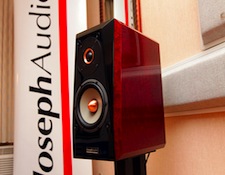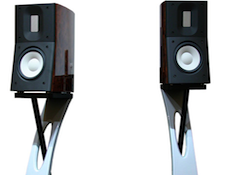It’s the time of year for saving money!
I’ve written many times in the past about the trials and tribulations of trying to fit a large speaker into a small room. Sometimes you shouldn’t even try to shoehorn a big speaker into a small room – there was no way the 6ft tall 550 lb. Dunlavys would even make it down the stairs in my new listening room, let alone have enough breathing room if they did manage to somehow get down the stairs.
 But audiophiles persist in trying to fit the biggest speakers possible into their rooms and then complain about coupling, resonance, and imaging issues. Anyone who’s attended an audio show has heard for themselves what happens when you put a big speaker into a small room – bad sound. I have a solution to this regularly occurring problem – instead of trying to find the largest speaker that will fit into your room, why not look for the smallest speaker?
But audiophiles persist in trying to fit the biggest speakers possible into their rooms and then complain about coupling, resonance, and imaging issues. Anyone who’s attended an audio show has heard for themselves what happens when you put a big speaker into a small room – bad sound. I have a solution to this regularly occurring problem – instead of trying to find the largest speaker that will fit into your room, why not look for the smallest speaker?
There are a lot of very good reasons for using a small speaker in a conventionally sized room. First with a smaller footprint speaker you have more placement options – you can actually put the speakers where they perform best instead of where they barely fit. With my Dunlavy SC VI speakers I purpose-built a room to go around them, picking the least pernicious room dimensions and surfaces, but in the end I still had only a range of five or six inches of placement options for the speakers because of their size.
When I put the much smaller AV123 Skiing Ninja X-Static speakers into this room I had several feet of placement options to explore and the best and final position was far better than the starting point, which was the area vacated by the Dunlavys.
 The primary disadvantage of a small speaker is that it may not be sufficient to pressurize a room like a big speaker. Also a small speaker can run out of dynamic headroom sooner. But if you choose a high-performance small-footprint speaker, such as the Joseph Audio Pulsar or Raidho D-1 and combine them with a top-flight subwoofer, such as the JL Audio F-112, the performance can be better than what you could obtain with any oversized speaker in a similarly sized space.
The primary disadvantage of a small speaker is that it may not be sufficient to pressurize a room like a big speaker. Also a small speaker can run out of dynamic headroom sooner. But if you choose a high-performance small-footprint speaker, such as the Joseph Audio Pulsar or Raidho D-1 and combine them with a top-flight subwoofer, such as the JL Audio F-112, the performance can be better than what you could obtain with any oversized speaker in a similarly sized space.
In my new room I intend to focus my reviews on smaller footprint speakers combined with subwoofers because they will fit into the room – why try to review any component in an inappropriate or compromised environment? Also I believe that most audiophiles, especially younger audiophiles, have to deal with smaller rooms that were not purpose-built for audio reproduction, so reviews of speakers that can work well in such environments will have greater value to my readers.
And yes, that old cliché, “small is beautiful” certainly applies to loudspeakers in rooms.





